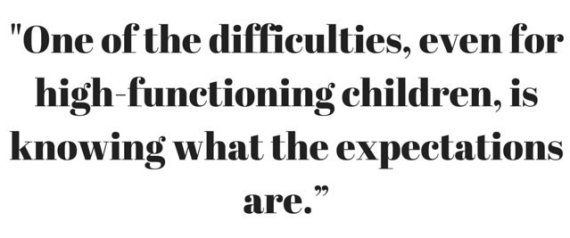Last year, Hanna Rosin, a well-known journalist for the Atlantic, wrote an article about her son’s Asperger's diagnosis. He lived with this label for only four months, at which point the disorder was expunged from the DSM V. Now, her son is said to be on the “autism spectrum,” along with one out of every 68 children in the U.S.
Autism spectrum disorder (ASD), a newly popularized term which encompasses a breadth of social impairments, repetitive behaviors and communication “deficits,” reflects this different thinking. The flexibility of the spectrum means that it can be applied to children on either end, from highly functioning individuals to those who can’t speak or communicate even their most basic wishes.
According to Rosin, “the newly explicit spectrum thinking gives at least the illusion that there are no fixed boundaries at all. Taken to its logical extreme, the perspective implies an unbroken continuum among minds that extends from autism all the way into the realm of the normal.”
But with this flexibility comes ambiguity -- especially in the classroom. The majority of teachers are not equipped to give students on various points across the autism spectrum the unique attention they require. For help, they have been turning to assistive technology.
“Teachers are becoming more comfortable with technology,” Jules Csillag, a speech-language pathologist in New York City who focuses on technology and special education, told The Huffington Post. “More and more, it is allowing them to customize a curriculum for students [with ASD].”
According to Csillag, there are two main types of assistive technology for students with ASD: Teaching technologies and communication technologies. While both tools are exceptionally important, a student’s ability to communicate is tantamount to his or her success. “The tricky thing about classrooms is that there are so many unspoken rules,” she said. “I think one of the difficulties, even for high-functioning children, is knowing what the expectations are.”
Kathryn deBros, a special educator in Vermont working with children with behavior disorders, has voiced similar sentiments. “A huge part of going to school is learning how to navigate social situations,” she said. “[Students with ASD] are totally lost without a roadmap. Technology has been huge in allowing them to bridge that gap between them and the other kids.”

For students with ASD who are especially low-functioning communicators, Csillag recommends a group of apps called Visual Scene Displays -- a type of augmentative and alternative communication (AAC) -- that give detailed context to common situations. She cited an app called Scene Speak, as well as more dynamic ones like TouchChat, Look2Learn and Tobii Sono Flex. The latter programs turn symbols into speech, allowing less-verbal children a better way to communicate.
As a more specialized classroom educator, deBros focuses on the tools geared around emotion for classroom support, such as Empatico, and organizational support, like Boardmaker. “Some of these kids are lost in social situations,” she explained. “But with an iPad in front of them, it really just clicks.”
Assistive technology is helping those with ASD outside the classroom, as well. “Part of the ASD difficulty is that society is not built in a way that is easy [for the child] to be in,” Csillag says. She further explains that even a grocery store or movie theater can be filled with distractions and triggers that will continue to elicit autistic behaviors, regardless of how much improvement the child can make in his or her own communications. However, with a better understanding of what autism is, and newer tools that help those with ASD communicate with others, the societal factor is becoming less of an issue while the unique strengths of those with autism are being spotlighted.
Despite the fact that employment rates for those with ASD have historically been abysmally low, companies like Microsoft are going out of their way to create work environments more friendly to people with autism. Mary Ellen Smith, a Microsoft VP whose son has ASD, announced the software company’s new hiring program for people with autism in a recent blog post. “People with autism bring strengths that we need at Microsoft,” she said, adding that “some have amazing ability to retain information, think at a level of detail and depth, or excel in math or code.”
Technology isn’t just helping those with autism learn; it is actually allowing them to thrive, and on some level, is becoming a more seamless component of their social selves. deBros compared the evolution of assistive technology to wearable devices: “In the future, technology will be much more integrated with the person,” she predicted. “It will allow them to function without the burden of going back and forth with the technology and the world around them.”
Cisco is committed to inspiring more people to pursue STEM education and careers. Through mentoring, IT training, and support for schools and nonprofits, they are working to increase the pipeline of STEM talent around the world.